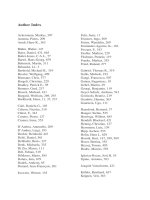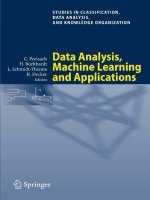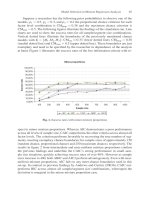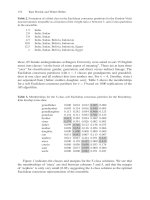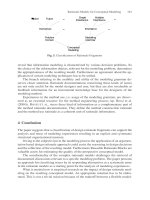Data Science Machine Learning Full Stack Roadmap Himanshu Ramchandani M Tech
Bạn đang xem bản rút gọn của tài liệu. Xem và tải ngay bản đầy đủ của tài liệu tại đây (340.7 KB, 25 trang )
DataScience
MachineLearning
FullStackRoadmap
HimanshuRamchandani
M.Tech|DataScience
TheRoadmapisdividedinto12Sections
Duration:100Hours(4to5Months)
1.PythonProgrammingandLogicBuilding
2.DataStructure&Algorithms
3.PandasNumpyMatplotlib
4.Statistics
5.MachineLearning
6.NaturalLanguageProcessing
7.ComputerVision
8.DataVisualizationwithTableau
9.StructureQueryLanguage(SQL)
10.BigDataandPySpark
11.DevelopmentOperationswithAzure
12.FiveMajorProjectsandGit
TechnologyStack
Python
DataStructures
NumPy
Pandas
Matplotlib
Seaborn
Scikit-Learn
Statsmodels
NaturalLanguageToolkit(NLTK)
PyTorch
OpenCV
Tableau
StructureQueryLanguage(SQL)
PySpark
AzureFundamentals
AzureDataFactory
Databricks
5MajorProjects
GitandGitHub
1|PythonProgrammingandLogicBuilding
Basics
01.
Variables
02.
Printfunction
03.
Inputf romuser
04. DataTypes
a. Numbers
b. Strings
c. Lists
d. Dictionaries
e. Tuples
f. Sets
g. OtherTypes
05.
Operators
a. ArithmeticOperators
b. RelationalOperators
c. BitwiseOperators
d. LogicalOperators
06.
Typeconversion
ControlStatements
1. IfElse
a. If
b. Else
c. ElseIf
d. IfElseTernaryExpression
2. WhileLoops
a. NestedWhileLoops
b. Break
c. Continue
d. pass
e. Loopelse
Lists
1. ListBasics
2. ListOperations
3. ListComprehensions
4. ListMethods
Strings
1. StringBasics
2. StringLiterals
3. StringOperations
4. StringComprehensions
5. StringMethods
ForLoops
1. Functions
2. NestedForLoops
3. Break
4. Continue
5. Pass
6. Loopelse
Functions
1. Definition
2. Call
3. FunctionArguments
4. DefaultArguments
5. Docstrings
6. Scope
7. SpecialfunctionsLambda,Map,andFilter
8. Recursion
9. FunctionalProgrammingandReferenceFunctions
Dictionaries
1. DictionariesBasics
2. Operations
3. Comprehensions
4. DictionariesMethods
Tuples
1. TuplesBasics
2. TuplesComprehensions
3. TupleMethods
Sets
1. SetsBasics
2. SetsOperations
3. Union
4. Intersection
5. DifferenceandSymmetricDifference
FileHandling
1. FileBasics
2. OpeningFiles
3. ReadingFiles
4. WritingFiles
5. EditingFiles
6. Workingwithdifferentextensionsoffile
7. WithStatements
ExceptionHandling
1. CommonExceptions
2. ExceptionHandling
a. Try
b. Except
c. Tryexceptelse
d. Finally
e. Raisingexceptions
f. Assertion
Object-OrientedProgramming
1. Classes
2. Objects
3. MethodCalls
4. InheritanceandItsTypes
5. Overloading
6. Overriding
7. DataHiding
8. OperatorOverloading
RegularExpression
1. BasicREfunctions
2. Patterns
3. MetaCharacters
4. CharacterClasses
Modules&Packages
1. Differenttypesofmodules
2. Createyourownmodule
3. BuildingPackages
4. Buildyourownpythonmoduleanddeployitonpip
MagicMethods
1. Dunders
2. OperatorMethods
2|DataStructure&Algorithms
AnalysisofAlgorithms
Typesofanalysis
AsymptoticNotations
BigO
Omega
Theta
RecursionandBacktracking
Stack
Queue
CircularQueue
Trees
LinkedLists
InsertionwithStack
InsertionwithQueue
Deletion
Sorting
BubbleSort|SelectionSort|InsertionSort|QuickSort
MergeSort
Searching
LinearSearch|BinarySearch
3|PandasNumpyMatplotlib
Numpy
1. UnderstandingNumpy
2. Basicworking
3. Workingwithdimensionsandmatrix
4. StatisticsbasicsMainlydescriptive
5. Linearalgebraoperations
Pandas
1. Dataframebasics
2. Differentwaysofcreatingadataf rame
3. Read-writetoexcel
4. Handlingmissingvalues
5. Groupingdata
6. MergingandConcatdataf rames
Matplotlib
1. Introduction
2. Formattingstrings
3. Legend,grid,axis,labels
4. Barchart
5. Histogram
6. Piechart
4|Statistics
DescriptiveStatistics
MeasureofFrequencyandCentralTendency
MeasureofDispersion
ProbabilityDistribution
GaussianNormalDistribution
SkewnessandKurtosis
HypothesisTesting
TypeIandTypeIIerrors
t-Testanditstypes
RegressionAnalysis
ContinuousandDiscreteFunctions
GoodnessofFit
NormalityTest
ANOVA
Homoscedasticity
LinearandNon-LinearRelationshipwithRegression
InferentialStatistics
t-Test
z-Test
Hypothesis
OnewayANOVA
TwowayANOVA
Chi-SquareTest
Implementationofcontinuousandcategoricaldata
5|MachineLearning
LinearRegression
1. SimpleLinearRegression
a. Evaluatingthefitnessofthemodelwithacost
function
b. SolvingOLSforsimplelinearregression
c. Evaluatingthemodel
2. MultipleLinearRegressionPolynomialregression
3. Applyinglinearregression
4. Exploringthedata
5. Fittingandevaluatingthemodel
6. Gradientdescent
7. WorkingwithDifferentdatasets.
8. Howtoapproachdatascienceproblems
9. Datasets
a. HousePricePrediction
b. SalarypredictionbasedonGMATscore
c. PredictingthesoldpriceofplayersinIPL
10.
Summary
LogisticRegression
1. LogisticRegression
2. BinaryClassification
3. PerformanceMatrix
4. Accuracy
5. PrecisionandRecall
6. F1measure
7. ROCAUC
8. HowtoapproachClassificationproblems
9. Datasets
a. PredictingInsurance
b. Spamfiltering
c. DigitClassification
d. TitanicDataset
10.
Summary
DecisionTree
1. DecisionTree
2. NonlinearClassificationandRegression
3. Trainingdecisiontrees
4. Selectingthequestions
5. Informationgain
6. Giniimpurity
7. ImplementationwithScikit-learn
8. Workingwithdatasets
a. SalaryPrediction
9. Summary
RandomForest
1. Ensemble
2. Bagging
3. Bosting
4. Stacking
5. Fastparameteroptimizationwithrandomizedsearch
6. Datasets
7. Summary
NaiveBayes
1. NaiveBayesmathematicalconcept
2. Bayes'theorem
3. Generativeanddiscriminativemodels
4. NaiveBayes
5. AssumptionsofNaiveBayes
6. Solvingdatasetwithproblems
7. Summary
UnderstandingInterviewquestions
DataScienceandMachineLearninginterviewquestionswith
answers.
SupportVectorMachines
1. SupportVectorMachines
2. LinearSVMClassification
3. NonlinearSVMClassification
a. PolynomialKernel
b. AddingSimilarityFeatures
4. SVMRegression
a. UndertheHood
5. Hyperparameteroptimization
6. Summary
MachineLearningAdvancedConcepts
1. GradientDescent
2. GDforLinearRegression
3. StepsforBuildingMachineLearningModels
4. MeasuringAccuracy
5. Bias-VarianceTrade-off
6. ApplyingRegularization
7. RidgeRegression
8. LASSORegression
9. ElasticNetRegression
10.
PredictiveAnalytics
11. ExploratoryDataAnalysis.
Clustering
1. Howclusteringworks
2. EuclideanDistance
3. K-meansclustering
4. Featurenormalization
5. Workingwithdatasets
6. Clusterinterpretation
7. Summary
RecommendationSystems
1. Associationrules
2. Collaborativefiltering
3. Similarities
4. Surpriselibrary
5. BuildingRecommendationEngine
6. Euclideandistancescore
7. Pearsoncorrelationscore
8. Generatingmovierecommendations
9. Summary
6|NaturalLanguageProcessing
TextAnalytics
1. Sentimentanalysis
2. Workingwithdataset
3. Textpreprocessing
4. StemmingandLemmatization
5. SentimentclassificationusingNaiveBayes
6. TF-IDF
7. N-gram
8. Buildingatextclassifier
9. Identifyingthegender
10.
Summary
SpeechRecognition
1. UnderstandingAudioSignals
2. Transformingaudiosignalsintothef requencydomain
3. Generatingaudiosignalswithcustomparameters
4. Synthesizingmusic
5. Extractingf requencydomainfeatures
6. BuildingHiddenMarkovModels
7. Buildingaspeechrecognizer
8. Summary
7|ComputerVisionwithPyTorch
NeuralNetworks
1. Introduction
2. Buildingaperceptron
3. Buildingasinglelayerneuralnetwork
4. Buildingadeepneuralnetwork
5. Buildingarecurrentneuralnetworkforsequentialdata
analysis
6. Visualizingthecharactersinanopticalcharacter
recognitiondatabase
7. Buildinganopticalcharacterrecognizerusingneural
networks
8. Summary
ConvolutionalNeuralNetworks
1. IntroducingtheCNN
2. UnderstandingtheConvNettopology
3. Understandingconvolutionlayers
4. Understandingpoolinglayers
5. TrainingaConvNet
6. Puttingitalltogether
7. ApplyingaCNN
8. Summary
ImageContentAnalysis
1. Introduction
2. OperatingonimagesusingOpenCV-Python
3. Detectingedges
4. Histogramequalization
5. Detectingcorners
6. DetectingSIFTfeaturepoints
7. BuildingaStarfeaturedetector
8. Buildinganobjectrecognizer
9. Summary
BiometricFaceRecognition
1. Introduction
2. Capturingandprocessingvideof romawebcam
3. BuildingafacedetectorusingHaarcascades
4. Buildingeyeandnosedetectors
5. PerformingPrincipalComponentsAnalysis
6. PerformingKernelPrincipalComponentsAnalysis
7. Performingblindsourceseparation
8. Buildingafacerecognizer
9. Summary
IntegrationwithWebApps
1. UnderstandingFlask
2. RecallingHTMLCSSJavaScript.
3. IntegrateFlaskandMachineLearning
Deployment
1. Flask
2. Heroku
ExtraProjects
1. BreastCancerClassificationusingScikitLearn
2. FashionClassclassificationusingTensorFlowandPyTorch
3. DirectingCustomerstoSubscriptionThroughApp
BehaviorAnalysis
4. Minimizingchurnratethroughanalysisoffinancialhabits.
5. CreditCardf rauddetection.
6. LiveSketchwithWebcamusingOpenCV
7. BuildingChatbotwithDeepLearning.
8|DataVisualizationwithTableau
Howtouseit
VisualPerception
Tableau
Whatisit
Howitworks
WhyTableau
InstallingTableau
ConnectingtoData
Buildingcharts
Calculations
Dashboards
Sharingourwork
AdvancedCharts
CalculatedFields
CalculatedAggregations
ConditionalCalculation
ParameterizedCalculation
9|StructureQueryLanguage(SQL)
SetupSQLserver
BasicsofSQL
Writingqueries
DataTypes
Select
Creatinganddeletingtables
Filteringdata
Order
Aggregations
Truncate
PrimaryKey
ForeignKey
Union
MySQL
ComplexQuestions
SolvingInterviewQuestions
10|BigDataandPySpark
BigData
WhatisBigData?
HowisBigDataappliedwithinBusiness?
PySpark
ResilientDistributedDatasets
Schema
LambdaExpressions
Transformations
Actions
DataModeling
DuplicateData
DescriptiveAnalysisonData
Visualizations
MLlib
MLPackages
Pipelines
Streaming
PackagingSparkApplications
11|DevelopmentOperationswithAzure,GCPor
AWS
FoundationofDataSystems
DataModels
Storage
Encoding
DistributedData
Replication
Partitioning
DerivedData
BatchProcessing
StreamProcessing
MicrosoftAzure
AzureDataWorkloads
AzureDataFactory
AzureHDInsights
AzureDatabricks
AzureSynapseAnalytics
RelationalDatabaseinAzure
Non-relationalDatabaseinAzure
12|FiveMajorProjectsandGit
Git-VersionControlSystem
Wefollowproject-basedlearningandwewillworkonallthe
projectsinparallel.
JointheDataScience&MLFullStack
WhatsAppGrouphere:
Connectwithmeontheseplatforms:
Twitter:h
ttps://twitter.com/hemansnation
LinkedIn:h
ttps://www.linkedin.com/in/hemansnation/
GitHub:h
ttps://github.com/hemansnation
Instagram:h
ttps://www.instagram.com/masterdexter.ai/
ContactforanyQuery:+919074919189
EndofDocument
